FUTURESCAPE SUMMIT vol.1 第1部|ゲストプレゼンテーション
Futurescape Summit Vol.1
【Part1|Guest Presentations】
2020年10月10日、公共空間を創造的に活用する世界諸都市と連携し互いの経験と知見を交換し合うことを目的としたオンラインシンポジウム「フューチャー・スケープ サミット vol.1」を開催しました。
第一部では、イギリス・リーズ市と中国・香港からの4名のゲストによるプレゼンテーションをお聞きしました。
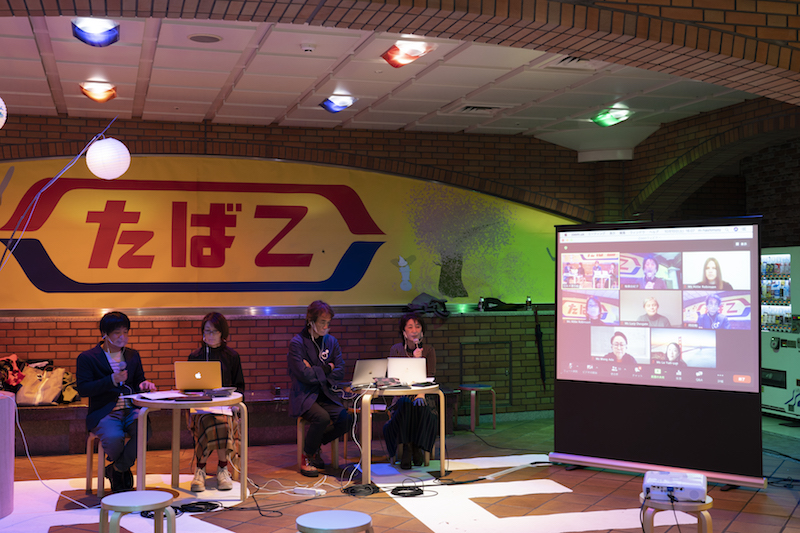
登壇者:アッベ・ロビンソン/「ライトナイトリーズ」アーティスティック・ディレクター(イギリス・リーズ市)
こんにちは、アッベ・ロビンソンと申します。リーズ市役所のアートプロジェクト担当主任として、「ライトナイトリーズ」のような芸術祭のプロダクションや芸術プログラムの担当をしています。
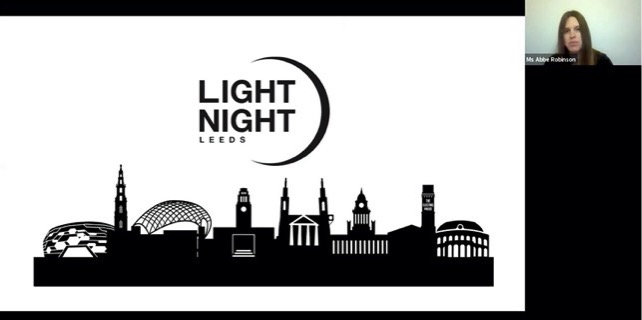
リーズ市はあまり知られていないと思いますが、実はロンドンとバーミンガムに続くイギリス第3の都市です。国内からも海外からもアクセスが良く、年間約2千万人が訪れます。産業革命期に繊維産業で成長を遂げ、今は製造業や金融業も盛んです。
3つの大きな大学と4つの劇場、16の博物館、オペラ、バレエカンパニー、アートギャラリーがあり、非常に文化的な生活が送れる場所です。国際映画祭「Leeds International Film Festival」や、「West Indian Carnival」、世界クラスの彫刻展「Yorkshire Sculpture International」など年間を通してたくさんのイベントが行われており、中でも10月に行われるライトナイトリーズは注目を浴びています。
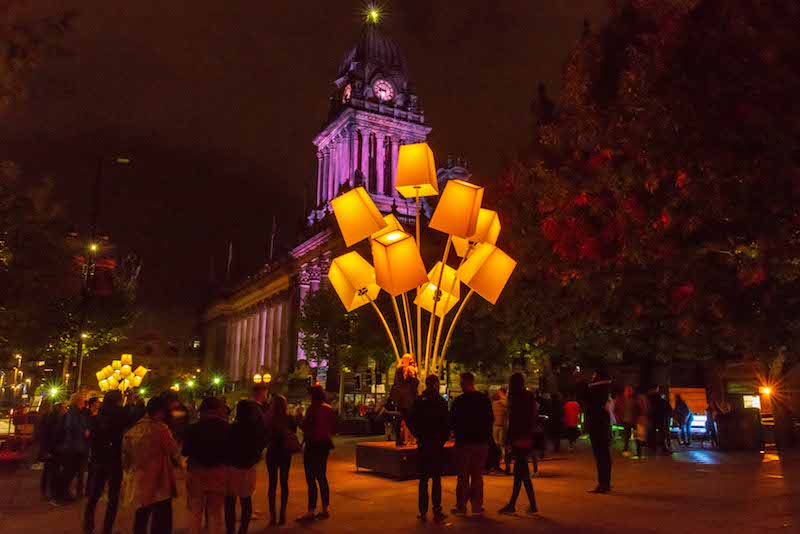
今年で16年目となるこのイベントは、特にこの5年間においては、アーツカウンシルイングランドの助成やたくさんの企業がスポンサーにつき、大きく成長しました。光のインスタレーション、インタラクティブアート、ダンス、ストリートシアターなど、屋内外の公共空間にて2日間で60以上のイベントが行われ、2019年は15万人以上が来てくれました。国内外の何百人ものアーティストを招待し、ここ数年は2023年の欧州文化首都の指定都市を目指して国際的なパートナーシップも探ってきました。ブレグジットで指定は不可能になりましたが、ナイトライトリーズの取り組みは続いています。
2019年のテーマは「マインド・ボディ・スピリット」でした。多くのプロジェクトはコミュニティ参加型で、市のメインストリートで行われるオープニングパレードでは、市民がクリエイターやパフォーマーと一緒にショーを作り上げました。

ライトナイトリーズはフェスティバルとしていくつかのネットワークに参加しています。LUTN(Light Up The North)はイングランド北部の6つのフェスティバルのネットワークで、定期的に集まって事例を共有したり、コラボレーションしたりしています。このネットワークではSHINEという新進アーティストのためのプログラムを実施しました。アーティストを選出・指導し、ネットワークの各イベントを回って出展してもらうためのライトアート作品の制作を依頼しました。LUTNは、もう少しキャリアのあるアーティストにフェスティバルに参加してもらうための新しいプロジェクトを開発してもらうためのラボとして機能しています。
ILO(International Light Festival Organisation)は入ったばかりですが、国際的に拡大中のネットワークです。特にヨーロッパ中心ではありますが、今年はルーマニアのパートナーフェスティバルの作品をライトナイトリーズで受け入れることになっています。
新型コロナウイルスの影響で今年はこれまでと同じかたちでは開催できませんが、10月22日〜24日のレイザーライトシティを皮切りに、長期展示のインスタレーションやオンラインイベントを実施します。レイザーライトシティは、アーティストのセブ・リーさんがリーズ市内の7つのランドマーク的なビルに巨大なレーザーを設置し、何マイルも離れたところからも見える光のスペクタクルを作り出すものです。市民は自分のスマホやパソコンからこのレーザー光の動きや色を操作することができます。現地でも、家でライブストリーミング映像を見ながらでもできるようになっています。
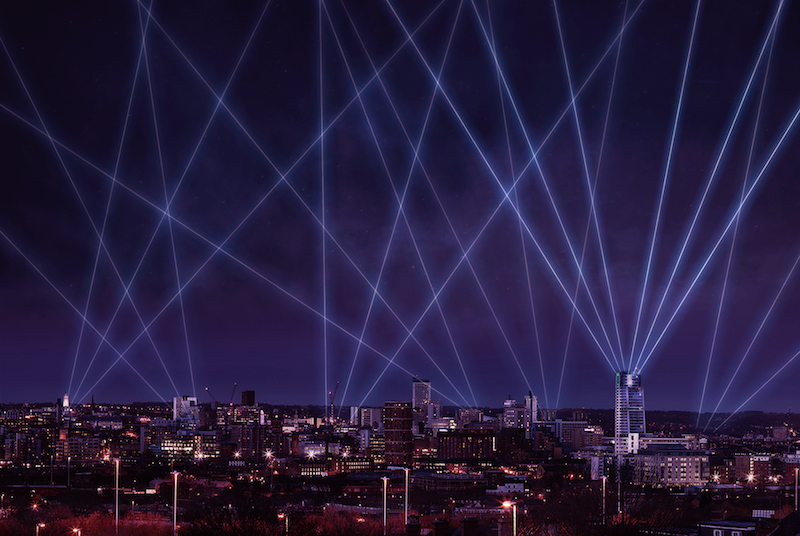
ウォーターフロントエリアには、2つの半恒久的なインスタレーションを設置します。2020年の経験を反映して作られた、「I MISS YOU」というテキストメッセージの作品と、地元の若者とネオンサイン専門店が作った「Glory」という虹のネオンサインです。虹は、医療従事者やエッセンシャルワーカーたちに感謝するためのシンボルとしてこのパンデミックの間使われています。
来年には元の形で実施できればと思っていますが、代わりの方法を探さないといけないかもしれません。今年はアーツカウンシルの助成金が出ず、これまで獲得してきたスポンサーからの資金も今後も入るとは限りません。
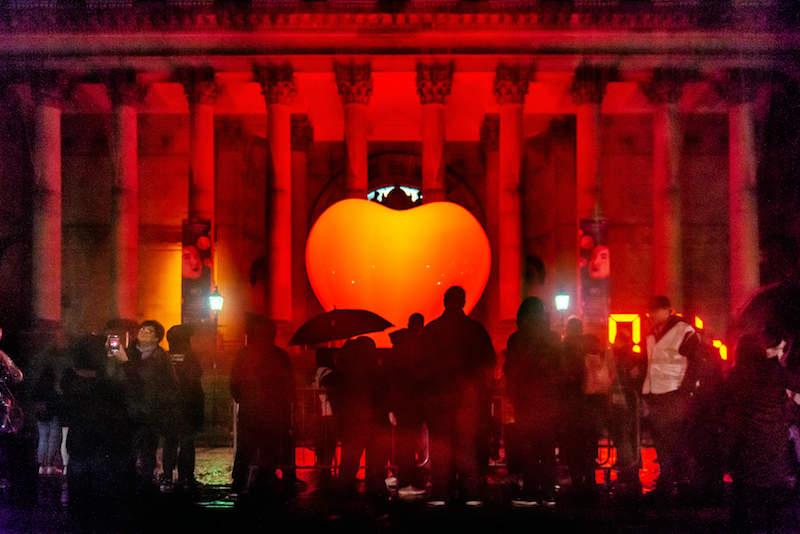
次に、私の仲間でインターナショナルパートナーシップを担当しているルーシー・ダスゲートにマイクを渡したいと思います。
登壇者:ルーシー・ダスゲート/クリエイティブプロデューサー(イギリス・リーズ市)
私はテクノロジーとそれが生み出す美というものに魅了されてライトアートに携わるようになりました。2014年に横浜でもNVAによる《Speed of Light》のパフォーマンスがありましたが、私は2012年にこのパフォーマンスを120人のLED装飾を施したランナーたちと行いました。
屋外アートに注力している素晴らしいアーティストや組織はたくさんいて、複数のフェスティバルを巡回できるようなフレキシブルな作品を作ることもあります。私の役割は、こうした作品をコミッショナー・プロデューサー・キュレーターとしてさまざまなフェスティバル団体につなぐことです。
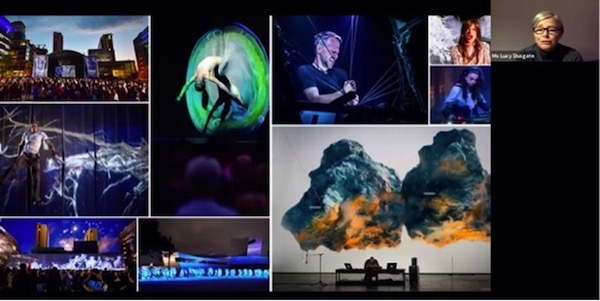
ライトナイトリーズは今年、カナダの組織Partnership Des Spectacles(PDQS)と共同事業を行うことができました。組織間でまず契約を交わしたことで、アーティストと新しい委託契約を結ぶことができたのです。国際的で複雑な交渉に注力できるスタッフを置くことは、このプロセスに欠かせないと考えています。
登壇者:ウォン・アダ/Make a Difference Institute(MaD)代表(中国・香港)
私の方からは、香港で何が起こっているのかということで、民間の文化機関の観点からお話したいと思います。
Make a Difference Institute (MaD)は非営利組織で、香港のパブリックカルチャーを作っていくためのイベントを行っています。私たちのミッションは、香港市民の参加を促すためにクリエイティビティがどのように活用できるかを実験していくことです。

香港政府は西九龍地区(ウェストカオルーン)を新たな文化地区として開発してきましたが、ヴィクトリア・ハーバーを見渡せるメインエリアは誰もが出入りできる公園になりました。8年以上前になりますが、私たちはこの公園がどうあるべきか行政と協議し、この場所で実験的なイベント「Freespace Happening」をキュレーションさせてもらうことになりました。
大きな芝生の上で開催した「Lawn Fest」では、オープンコールバンドショーで集まったバンドが8時間も生演奏してくれました。香港ではこのような光景は珍しいので、皆さん芝生に座ってピクニックをしてくれました。

また、クリエイティブな若者たちが「物を売買するだけでなく、自分たちの仕事を発表するためのマーケットがやりたい」と言ってくれました。このマーケットを出店料ゼロにして開催したところ、さまざまなクリエイティブな出展者が集まりました。ほとんどの人は物を売っているわけではなく、自分が作ったものを展示したりアイデアを共有したりしていました。

アーティストのケイシー・ウォンさんによる「インスタント・スカイライン」という公共空間でのインスタレーションでは、市民の皆さんが手すりに自分たちの高層ビルを並べる参加型のワークショップを行いました。港の反対側にある本当のスカイラインに呼応した、もう一つの小さな作品たちです。

香港ではほぼ毎晩行っている光のショー「シンフォニー・オブ・ライツ」がありますが、香港にはこのショーが好きでない人たちも一部いるので、自分たちの小さなバージョンを作りました。小さな花火を使った、人々のためのショーです。多くの人たちが喜んでくれた素晴らしい一夜になりました。空間、イベントというのは本来こういう風に自分たちの手で作られるべきだと思っています。

MaDは10周年を迎え、いろいろなフェスティバルに招かれました。同じく西九龍公園ですが、別のフェスティバルの「Freespace Fest」では、アーティストが人々とコラボレーションしていろいろな作品を作ろうという試みを行いました。芝生の上のインスタレーションや、子どもたちが音を出して遊べるインスタレーション、建築家たちによる湾沿いのパビリオンもでき、暮らしと文化のショーケースになりました。
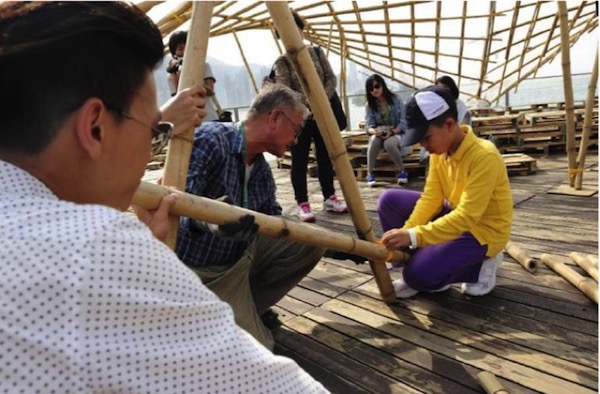

もう一つ、香港について皆さんがご存知でないかもしれないことがあります。香港の9割の公園は、ペットが入ることができないんです。おそらく植民地時代の法律に基づいたルールだと思いますが、香港にはペット好きな人が多いので、私たちは当局の許可を得てペットを公園に入れることについて考えるイベントを行いました。実験的なイベントですが、ペットを公園に入れるためにはどうしたらいいか、犬が嫌いな人や犬が怖い人たちの懸念はどうやったら取り除けるだろうかと皆で話し合い、Facebookページで協議を続けました。そこで出された提案を政府に持っていきました。
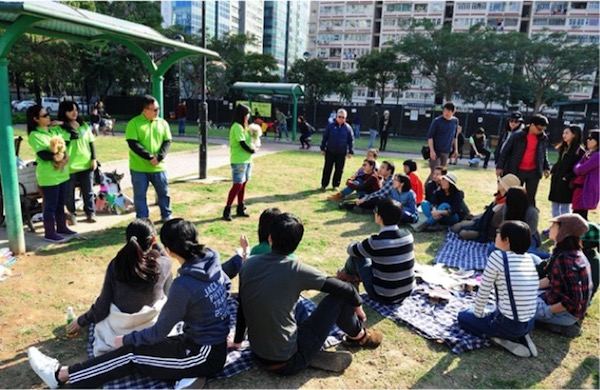
私たちは西九龍だけではなく、さまざまなコミュニティで活動してきました。香港大学の近くでは、坂道用のストリートファニチャーの作り方をデンマーク・コペンハーゲンのアーティストから学ぶ「エクスペリエンス・ハンズアップ」というプロジェクトを行いました。各地から公募で集まった若者たちが、3週間で廃木材を使って家具をデザインしました。急な坂なので、椅子の脚は長さを変えなければいけなかったことが分かります。出来上がったほとんどの家具はそのまま置いておくことにしたので、この通りは地域の共同リビングになりました。最終日にはパーティーを開き、住民たちも参加してくれました。
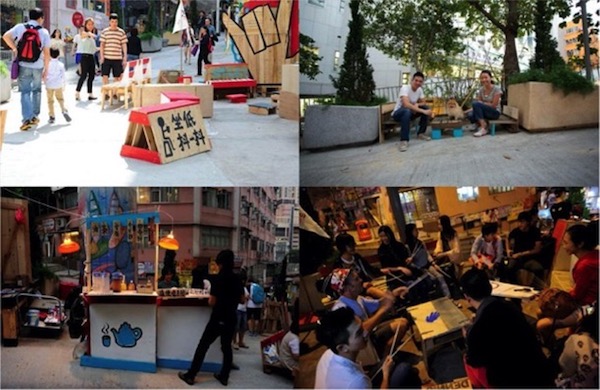
最後にご紹介したいプロジェクトは「SOCIAL LAB(ソーシャルラボ)」です。私たちは行政でありヤンヤンさんの職場でもある香港康楽及文化事務署(LCST)を訪れて、住民や行政の職員と共に、自由で楽しい公園とはどんなものか、プロトタイプを作りたいと提案しました。そして、人とペットのための公園、「ダイアローグ・イン・ザ・パーク」、「パルクール・イン・パークス」、夜の公園を野外映画館に変身させる「パーク・イン・ザ・ダーク」、ウォーターフェスティバル「WeWet Festival」、「Park Lab 2.0」6つの提案を作りました。これらは公的に許可が必要なものなので、人々が楽しめるものだと政府に見せるために実験を行う必要がありました。新しいアイデアを少しずつ導入していき、ペットコーナーのアイデアは、LCSTが地区議会と共にさらに計画を進め、今では香港にペットコーナーのある公園が6つできました。
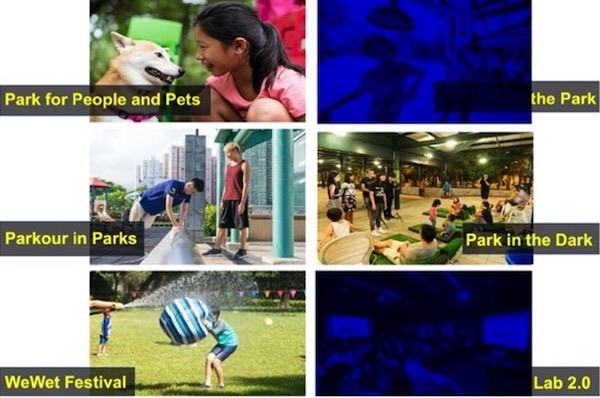
登壇者:ロー・ヤンヤン/香港康楽及文化事務署キュレーター(中国・香港)
香港康楽及文化事務署は、コミュニティアートと商業アートを推進するための行政の部署として2001年に設立されました。アーティストが借りられる機材やスタジオがある「香港ビジュアルアーツセンター(vA!)」と、若手アーティスト育成のための実験的プラットフォームである「オイルストリート・アートスペース(Oi!)」の2つのアートスペースを運営しています。
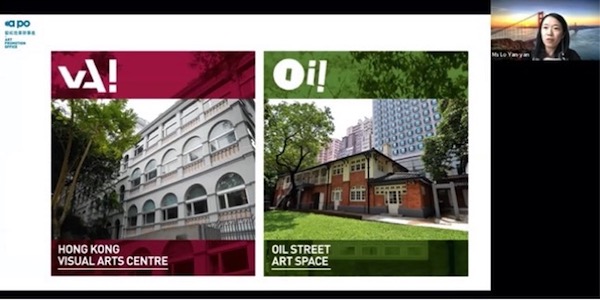
署内のパブリックアート部門では、公園や行政の建物、カルチャーセンター、時には郊外のオープンスペースを使って展示を行います。最近では、地域の歴史に基づいたサイトスペシフィックなパブリックアートをアーティストに委託することをメインに行っています。
21世紀のパブリックアートは、市民とどのように触れ合うかということに重きを置いています。「City Dress Up : Seats.Together」というプロジェクトでは、美的な魅力と機能性を併せ持つ家具という形で、それぞれの空間に合わせて作られた20のパブリックアート作品を公園やウォーターフロント、遊び場などに設置しました。作品が近隣のコミュニティが交流するためのプラットフォームとなることで、公共空間に対する人々の認識を変えることを目指しています。
建築家のロバート・ウォン氏は、ユーザーの参加でデザインされた施設こそ最も彼らのニーズに合わせたものにできるという信条を持っていました。彼は地元の高齢者たちを招いて作品のコンセプトづくりを行い、高齢者も自分たちの意見が取り入れられることに満足しました。
ワンバイトデザインスタジオは、人々が会話しやすくなる《TingTing》をリクリエーションの場にデザインしました。6つの席が3つのグループに分かれて設置されており、それぞれが周りの音を聞きながら他の席の人たちと話ができるサウンドミラーになっています。
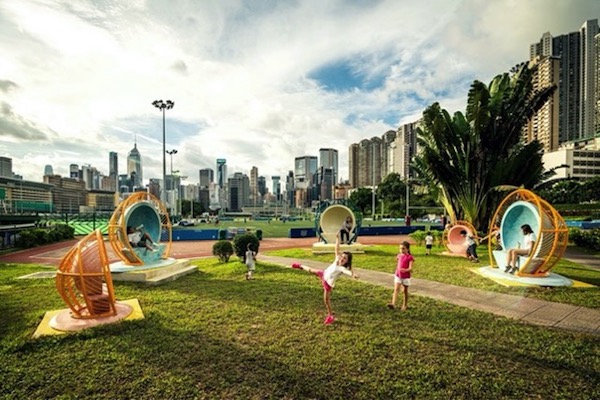
ビジュアルアーティストのロイ・ングさんは、波の音を出す楽器を内蔵した《Ocean Chair》を作りました。座るとまるで海辺にいるかのように自然のリズムを感じることができます。訪れた人に都会の喧騒を離れて浄化されたような気分を味わってほしいという思いで作られた作品です。
デザイナーのディラン・クウォックさんとヒンズ・パクさんは《Hack-a-Bench》という作品を作りました。公園のベンチを通常の用途や機能に基づいてリモデルする試みです。シンプルなパーツを加えることで、人々がリラックスしたりゲームをしたり、エキササイズやパフォーマンスができる創造的な空間を提供しました。
MIROというデザインチームは、公園にもともとあったベンチに背もたれやアームレスト、テーブルなどを追加して、家のように快適な空間を屋外に作り出しました。
建築家のエリック・トン氏は、海岸と水の動きにインスピレーションを得たアーティスティックな家具を瀑布湾公園(Waterfall Bay Park)にデザインしました。非常に細長い流線的なベンチで、時を止めた滝のようになっています。球体の椅子は、健康を保つアクティビティに使われています。
カカマデザインラボが別の公園用にデザインしたカラフルな什器は、さまざまな文化活動のためのプラットフォームになっています。
このプロジェクトは公共の家具やアート作品を作るだけでなく、ダイナミックでクリエイティブな空間を作り出すこと、そして楽しい芸術的体験だけでなく、社会的インパクトを生み出すことを目的としています。13の多様な専門分野の賞を受賞したことで、とても励みになりました。
私たちが近年関心を持っているのは、公園の使い方を再考し、その意義を高めることです。リラックスしたり、自然を楽しんだり、友達や家族と集まったりするという役割に加えて、公園は家になり得るのか?図書館には?といったことを考えています。住民のコミュニティへの帰属意識を高め、相互支援ネットワークの結びつきや効果を高めるためのアートプロジェクトを公園で実施していきたいと考えています。
「Take PARK in Art」は、香港の複数の公園で実施した実験的なイベントです。「City BioBlitz」チームを作り、参加者に公園の鳥や蝶や植物を観察・記録してもらいました。その観察記録はエコアーティストと一緒にドローイング作品にしました。一部の作品は公園のサインに使われています。
「Experience the Community Soundscape」は参加者が自然の音を探求し、街なかの音を集めて地域のサウンドマップを一緒に作っていくプロジェクトです。
「Reappearance of Memoryprint」では、高齢者と若者のグループがまちにまだ残る逸話を集め、
公共の場で即興で発表してくれました。
「Swap! In the Park」では、デザイナーたちが中古の服やアクセサリーを積んだ「モバイルワードローブ」を街なかで移動させ、不要な消費を減らすシェアリングエコノミーの考え方をプロモーションしました。
「WeWeave」はポップアップのパブリックアート共同制作アクティビティです。古い服をデザインやアイデアで新たな付加価値を持たせ、新しい服にアップグレードさせる方法や、布でひもを編む方法を習得し、不要なごみを減らすための「アップサイクル」という概念を学びました。
「Toy Regenerated」というプロジェクトでは、公園にトイコレクションボックスを設置して、誰でも自由にファストフードチェーンのおもちゃを持ち寄ったり持ち帰ったりできるようにしました。参加者は残ったおもちゃを材料にして新しいおもちゃを作り、生まれ変わったおもちゃで遊んで楽しんでくれました。
「i Light Aldrich Bay」では、アーティスト主導で住民たちがガラス瓶やプラスチックをアップサイクルし、光のインスタレーションを作りました。
その他フラッシュモブのコンサート、ダンスパフォーマンス、読み聞かせピクニック、瞑想のワークショップや楽器のアップサイクル、植栽などを行いました。こうした活動が住民たちのお互いを知るきっかけになればと思っています。公園がより柔軟な管理体制をとり、公共空間が利用者にとってより楽しい場所になることを目指しています。
屯門ニュータウンは1960年代に開発が始まった地区ですが、住民たちは交通の便が悪いと考えていました。屯門のコミュニティにアートを持ち込むことで、私たちは住民にプライドを持ってほしいと考えました。今年開始した「Viva! River」というプロジェクトでは、地元のアーティストたちによるパブリックアートで屯門の開発にアートの要素を加えました。これだけでなく、住民とアーティストがより活気のある公共空間を作るためにアートやデザインの視点で意見交換し、さまざまなコラボレーションが行われました。

香港の各地区がユニークな特徴を持っており、屯門には断片的な小話が無限にあります。コールドイアーファクトリーというアートグループは、路面にブースを設置して住民のコミュニティに関する記憶や感情、空想を収集しました。地域の歴史や奇妙な逸話、面白い逸話を元に、彼らは6つの銅像を制作しました。屯門の子どもが共有してくれた話の一つは、壁にある魔法の穴の話です。子どもがその穴に入ると体がビヨンと伸び、反対側の穴から入ると身長が縮むというものでした。この作品シリーズは、来訪者が屯門に関して空想を掻き立ててくれることを期待しています。
「ラ・ベル・エポック」というアートグループは、屯門の街角で猫が暮らしている痕跡を見つけ、人間と猫の共存をインスピレーションに「Meowy Go Round the River」という粘土の彫刻作品を屯門川沿いに展示しました。3年間、アーティストが定期的に猫の服を変えてくれます。住民向けの編み物教室も開きました。
「Sound of Rebound」という作品は、2つの円でできた斬新な見た目の卓球台です。天板が鉄琴になっているので、ボールが当たるとランダムな音色が奏でられます。円形なので複数のプレイヤーが同時にプレーでき、一緒にメロディを作り上げます。ミュージシャンがこの卓球台を使ってパフォーマンスも行ってくれました。
新型コロナウイルスのパンデミックの影響で、市民が地元に残り楽しみを求めて屋外に出るようになり、今まで忘れていた都市の魅力を再実感することになりました。「Hi! Flora, Fauna」は、香港動植物公園(HKZBG)の広報のためのアートプロジェクトです。17のグループのアーティストが園の動植物からインスピレーションを得て、来場者と自然を近づけるさまざまな形態の作品を制作しました。この企画は2020年12月まで開催されています。
On October 10, 2020, in partnership with cities worldwide that creatively use public space, Zou-no-Hana Terrace held Futurescape Summit Vol. 1 with the aim of exchanging experiences and insights.
In the first part of the summit, four guest speakers from Leeds in the UK and Hong Kong gave presentations.

Speaker: Abbe Robinson (Artistic Director, Light Night Leeds / Leeds, UK)
Hello, my name is Abbe Robinson. I’m Principal Arts Project Officer in the Arts Development Team at Leeds City Council, which is a section of our local government. My responsibility and role is for the artistic programming and the production of arts in the festival Light Night Leeds.

Leeds is perhaps not so well known overseas, but we’re actually the third largest city in the UK after London and Birmingham. It is quite accessible to visitors from both within the UK and from abroad, welcoming about 20 million visitors every year into the city. Leeds grew significantly during industrialization. It was at the center of the woolen textile trades, but is now a financial, legal, and manufacturing hub.
We have three universities in our city as well as four major theaters, sixteen museums, opera and ballet companies, and art galleries. It is a highly cultural place with a fantastic annual calendar of events and festivals in the city, from international film festivals to the West Indian Carnival, and a world-class sculpture festival. Light Night Leeds, which is our arts and light festival, takes place every October and is a very highly anticipated event in the cultural calendar.

Marking its sixteenth edition this year, the festival has grown significantly in scale, particularly over the past five years, due to receiving increasing amounts of Arts Council funding, and also growing levels of corporate sponsorship. For two evenings each year in October, we present over sixty different events all at the same time, across a range of art forms, which includes video mapping, light installations, interactive work, dance, and street theater, in both indoor and outdoor public spaces. In 2019, we welcomed 150,000 visitors over the two nights. We host a mix of hundreds of local, national, and international artists. Over the past few years, we’ve explored a number of international partnerships and opportunities for co-commissioning, as Leeds heads toward hosting a full year of culture in 2023.
Last year, our theme was “mind, body and spirit.” We tend to have community engagement each year with projects that members of the public can get involved in as creators and performers, and this includes our launch parade, which travels through the main streets of the city center on the first night of the event.

As a light festival, we try to connect with other similar events around the world and we are members of several networks. One of those is Light Up the North, a network of six light festivals across the north of England. We meet regularly with staff from those festivals to share best practices and to collaborate on new projects. With that network, we have made a project called Shine, an emerging artists program. We provide opportunities for mentoring as well as project and career development. We also look at touring opportunities for the new smaller scale artworks that they produce and bring them to our festivals. We also have a project called “Light Lab,” which is for mid-career light artists, and for them to develop larger-scale work for inclusion in our events.
We’ve just become part of the International Light Festivals Organisation, a growing network across the world, though predominantly in Europe at the moment. Initially, we’re hosting a piece of work made by one of our partner festivals in Romania.
Because of the coronavirus situation, we can’t present Light Night Leeds in its usual format this year. We will begin with a project called “Laser Light City” from October 22 to October 24, and hold long-term installations and online events. For “Laser Light City,” the artist Seb Lee-Delisle will install huge lasers on seven landmark buildings in the city, and which will create an illuminated spectacle across the Leeds skyline and that will be visible from several miles around. The fantastic thing about this project for us is that members of the public will be able to take control of the movement, color, and pattern of these lasers from their smartphone, tablet, or computer, either in person from somewhere where they have a view of the city, or from home by watching via our livestream video.

We’re also going to install two new semi-permanent light artworks in the waterfront area of the city. These are designed to reflect the experiences of 2020. We have a new text artwork called I Miss You, and also a large, full circle rainbow called Glory, which has been crafted by a neon artist working with local young people from Leeds. That will reflect what’s happened in the UK during the pandemic, where the rainbow symbol has been used for people to thank the National Health Service and people who are the key workers keeping the country going during the pandemic.
We’re hoping that Light Night Leeds can return to its full program in 2021, but things are still uncertain and we might need to look at alternative projects. We didn’t get our usual Arts Council grant this year and the corporate sponsorship we’ve built up might not be available in the future.

At this point, I’d like to hand over to my colleague Lucy Dusgate, who works with us as Night Light Leeds on our international partnerships.
Speaker: Lucy Dusgate (Creative Producer / Leeds, UK)
I became involved in light art through my fascination in technology and the beauty that it can make. A light festival can have performances, such as NVA’s Speed of Light, which was performed in Yokohama in 2014. I also presented this performance of moving light using over 120 illuminated runners in 2012.
There are many examples excellent artists and organizations professionally dedicated to outdoor art. Sometimes the artist works on site-specific commissions. Sometimes they create a work that is flexible enough to tour to multiple festivals. I’ve worked to deliver these kinds of works as a commissioner, producer, and curator for different festival organizations.
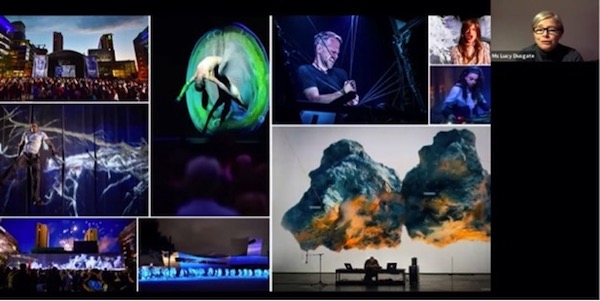
This year, we managed to achieve a new co-commissioning between Light Night Leeds and the Canadian festival organization Quartier des Spectacles. From initial discussions, we created an organization-to-organization contract of business, and were then able to commit to developing a new co-commission with an artist. These are complex international negotiations between cultural organizations. Having someone like myself in the network and dedicated time to develop the business-to-business agreements is vital for this process.
Speaker: Ada Wong (Chairperson, Make a Difference Institute [MaD] / Hong Kong, China)
I would like to share with you what is happening in Hong Kong from the citizens’ perspective. Make a Difference Institute (MaD) is a nonprofit that organizes events. But we don’t see them as mere events; we see them as building our public culture for Hong Kong. Our mission is to explore how creativity can encourage the citizens of Hong Kong to participate.
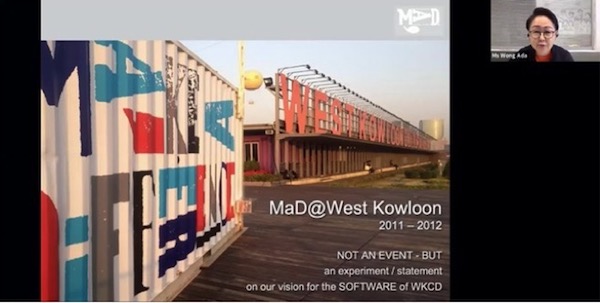
The Hong Kong government has committed to developing a new cultural district in West Kowloon. One of the major areas within that district is a park that is open to everyone and overlooks the beautiful Victoria Harbour. More than eight years ago, as people were wondering about what the park should be, we worked with the West Kowloon authority, which is a government organization. It let us curate the experimental event “Freespace Happening” on this piece of land.
We had a festival called Lawn Fest on the big lawn with eight hours of music from bands recruited by an open call. In Hong Kong, to have a large area where there is continuous band show is actually very rare. People enjoyed watching the bands and sat on the grass having picnics.

Creative young people told us: “We want to have a creative market not just for buying and selling, but perhaps to showcase what we have done.” We created a market but one without a fee for vendors, and so all forms of creative sharing could happen. A lot of the people are not really selling anything, but rather exhibiting what they made and simply sharing their ideas.
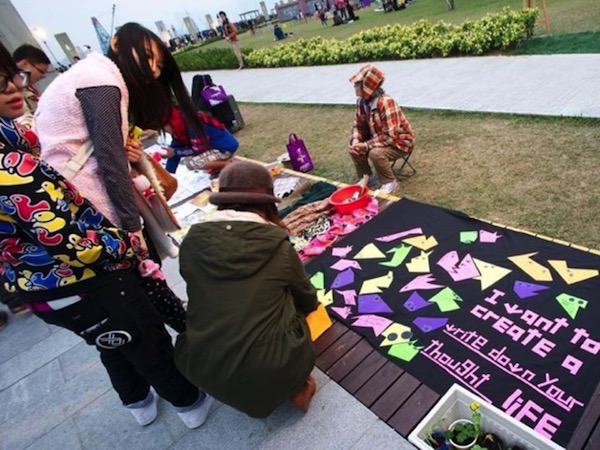
The artist Kasey Wong made a workshop in public space called “Instant Skyline,” in which people came and built their own skyscrapers just by putting the on the railing. These were small pieces of creativity that echoed the real skyscrapers on the other side of the harbor.
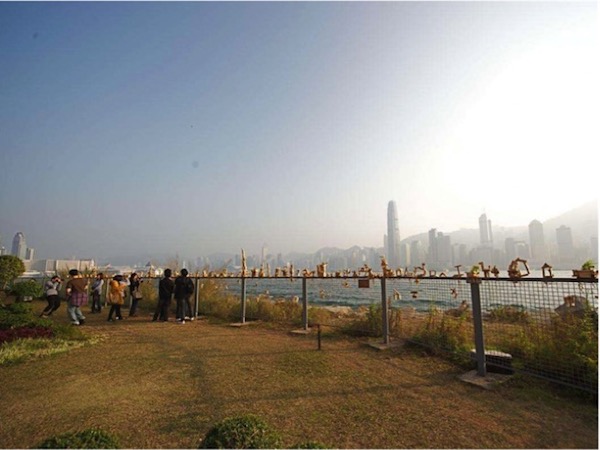
In Hong Kong, we have a light show every night called “A Symphony of Lights.” But some people of Hong Kong don’t really like the light show, so we decided to have a small show for them. It was “people’s version” of the show with just a few fireworks. The result was a fabulous evening that made a lot of people happy. I think that is how spaces should be created and how events should be created.

MaD is ten years old and we have been invited to participate in various festivals. “Freespace Fest” also uses West Kowloon Park but with a focus more on collaboration. We hope that artists can collaborate with people to come up with different artworks. It could be an installation on the grass or a very playful installation where children and parents can make sounds. We also had a group of architects build a very nice pavilion alongside the harbor. It became a showcase of life and culture.


One thing about Hong Kong that you might not know is that 90 percent of parks do not allow pets inside. This has been the case for a very long time, since the law is based on the idea of parks from the Victorian era, back when Hong Kong was still a colony. But we know that lots of people love pets in Hong Kong. With the permission of the government authorities, we have done events where we try to talk to people about the issues related to having pets inside parks, how we can address the concerns of people who are very afraid of dogs, and so on. A very good discussion came out of this and has continued on a Facebook page. We then compiled the proposals that emerged and submitted them to the government.

In addition to West Kowloon, we have worked with many other communities. Near the University of Hong Kong, there is a very steep road. We organized a project called “Experience Hands Up.” We engaged four artists from Copenhagen from Denmark to teach how to build street furniture for this road. We held an open call and young people came from everywhere and for three weekends designed furniture using very simple, old discarded wood. Because it’s a steep road, the legs of the stools and chairs had to vary. Most of the finished furniture was left there for the community, turning the street into a communal living room. And on the last day, we had a party and the residents came down to join in.

The final project I want to talk to you about is called “Social Lab.” We visited the Leisure and Cultural Services Department, where Lo Yan-yan works, and together with the civil servants and residents, we created prototypes for a free and happy park. We created six different proposals: Park for People and Pets; Dialogue in the Park; Parkour in Parks; Park in the Dark, where the park transforms into an outdoor movie theater; WeWet Festival, a water festival; and Park Lab 2.0. These things are not allowed in Hong Kong yet and that is why we need to conduct these experiments to show the government that people would enjoy doing them. And then we can gradually try to introduce new ideas. The Leisure and Cultural Services Department worked with the district council on the “pet corner” idea, and there are now six parks in Hong Kong that allow pets in certain sections.

Speaker: Lo Yan-yan (Curator, Art Promotion Office, Leisure and Cultural Services Department, Hong Kong Special Administrative Region Government / Hong Kong, China)
The Leisure and Cultural Services Department’s Art Promotion Office was established in 2001 as a dedicated government office for the promotion of community art and corporate art. Our office is responsible for the management of two art spaces: the Hong Kong Visual Arts Center (vA!), which contains studios and professional facilities that artists can rent; and Oil Street Art Space (Oi!), an experimental platform that aims to nurture young artists.

For displaying public art, we use public spaces in Hong Kong, such as parks, government buildings, cultural centers, or even the countryside. Most recent commissions have been for artists to create site-specific public artworks based on local history.
Public art in the twenty-first century has emphasized how our work engages the public. The “City Dress Up: Seats. Together” project featured twenty sets of public artworks in the form of aesthetically appealing and functional furniture, installed at different open spaces, including parks, waterfronts, and playgrounds. This project hopes to enhance people’s interpretation of public space by transforming the artistic furniture into creative platforms for neighborhood community interaction.
The architect Robert Wong believes that facilities should be designed with the participation of users in ways best suited to their needs. For “City Dress Up,” he invited senior citizens from neighboring communities to participate in developing the artistic concepts. During the design process, he listened to what the locals shared regarding their needs.
In this same project, One Bite Design Studio designed TingTing for one recreation site that makes it easier for people to strike up conversations. Six seats are arranged in three groups, forming a “sound mirror” that allows users to listen to songs in the surroundings while speaking with other visitors at the same time.

Still part of “City Dress Up,” visual artist Roy Ng designed Ocean Chair for a venue with a musical instrument installed in each armchair that plays the sounds of waves. Visitors sitting there feel the rhythm of nature as if they are right next to the sea. The artist hopes to beat the heart and soul of visitors, and purify the commotion of the city.
Hack-a-Bench by designers Dylan Kwok and Hinz Pak aims to remodel park benches based on the regular uses and functions. Through the addition of simple parts, they made a creative space for relaxing, playing games, exercising, and performance.
Design team MIRO made improvements to the original seats in a park by adding a backrest, armrest, and tables, bringing the comforts of home to an open space.
Inspired by the shoreline and the motion of water, architect Eric Tong designed special artistic furniture in Waterfall Bay Park. This incredibly long and thin, streamlined bench is like a waterfall frozen in time. The spherical chairs serve as recreation facilities that promote good health and wellbeing.
The colorful public furniture that KaCaMa Design Lab designed for another public forms a creative platform for various cultural activities.
“City Dress Up” not only produces pieces of public furniture or artworks, but also dynamic, creative spaces. It aims not just for pleasant aesthetic experiences, but also social impact. It is encouraging that the project has won thirteen in various specialist fields.
In recent years, we have taken a keen interest in imagining how a park is used and in extending that significance further. In addition to being a place for relaxation, appreciating nature, and friends and family to gather, can a park be a home? Or a library? We hope to initiate an art project in the parks to help strengthen the residents’ sense of belonging to the community, as well as enhance the cohesion and impact of mutual support networks.
“Take PARK in Art” is a series of experimental public events that took place in different parks in Hong Kong.
We organized “City BioBlitz,” inviting participants to observe and make a record of the birds, butterflies, and flowering plants in the parks. They also turned the record of their observations into drawings together with eco artists. Some of their works were selected and transformed into signage displays for the parks.
In “Experience the Community Soundscape,” participants explore the sounds of nature, collected the sounds of the city, and co-created a sound map of the district.
In “Reappearance of Memoryprint,” a group of people both elderly and young collected community stories and improvised a performance of them in public space.
In “Swap! In the Park,” designers brought a mobile wardrobe to travel around the city with old clothes and accessories, aiming to promote ideas of the sharing economy and reducing unnecessary consumption.
“WeWeave” was a public art co-creation activity. Participants learned ways to upcycle old clothes and weave fabric strips, and thought about the possibilities for public space. They acquired the idea of upcycling to reduce unnecessary waste.
The “Toy Regenerated” project placed a toy collection box in the park, where everyone could give and take home toys from fast food chains. Participants were then invited to create and build their own toys using the remaining toys as materials. They had a lot of fun playing with the regenerated toys.
In “i Light Aldrich Bay,” artists led the community in upcycling glass bottles and plastics into a light art installation that illuminates the park.
Other activities included flash mobs, concerts, dance performances, storytelling picnics, workshops about meditation, upcycling musical instruments, and planting. We hope these activities could help city residents get to know their neighbors. It was our aim to apply more flexible management structures to the parks, making public space more fun and enjoyable for all park users.
The development of Tuen Mun New Town started in the 1960s in Hong Kong. However, most residents think that Tuen Mun is remote and has no convenient transport links. By bringing art into this community, we hope to foster a sense of pride among residents. This year, we launched “Viva! River,” a public art project featuring a number of local artists, to offer new inspiration for the development of Tuen Mun. Various collaborations have taken place in communities, where residents and artists exchange ideas to envision a more vital model of public space from the perspective of art and design.

Each district in Hong Kong has its own unique characteristics and Tuen Mun is no exception, boasting an infinite number of narrative fragments. The art group Cold Ears Factory set up street booths to collect residents’ memories, feelings, and fantasies about the community. The team produced a series of six bronze sculptures based on the history of the district and its strange and intriguing stories. One of the stories shared by a local kid is about a magical hole in a wall. If, the story goes, a child passes through the hole on one side, his body would be stretched. But if he passed through the hole from the other side, his body would shrink. This series of works aims to stir people’s imaginations about Tuen Mun.
The art group La Belle Époque visited different corners of Tuen Mun and discovered signs of feline life, and then exhibited a series of knitted cat sculptures, Meowy Go Round the River, inspired by the harmonious coexistence between humans and cats in the area. Over three years, the artists are regularly changing the clothing of the cats, which are on display by the Tuen Mun River. They also held knitting workshops for residents.
Sound of Rebound is a novel-looking ping-pong table that we found, made up of two circles. The tabletop is a glockenspiel: random notes are produced when the ball rebounds onto the table, leading to a melody created by a group of people playing together. The circular design can accommodate multiple players at the same time, symbolizing harmony. Musicians make use of the ping-pong table as a performing stage.
Due to the coronavirus pandemic, people could not travel and instead went outdoors locally to seek amusement. As a result they rediscovered scenery they had forgotten and learned to appreciate the beauty of the city. “Hi! Flora, Fauna” is an art project that promotes the Hong Kong Zoological and Botanical Gardens. Seventeen groups of artists took inspiration from the flora and fauna in the park to make work with a range of different media to bring visitors closer to nature. This project will be held in December this year.
